Part C. Rules If You Do Not Have a Qualifying Child
Use Part C if you:
- Do not have a qualifying child, and
- Have met all the rules in Part A.
This part of the chapter discusses Rules 10 through 13. You must meet all four of these rules, in addition to the rules in
Parts A and D, to qualify for the earned income credit without a qualifying child.
 If you have a qualifying child, the rules in this part do not apply to you. You can claim the credit only if you meet all the rules in Parts
A, B, and D. See Rule 7 to find out if you have a qualifying child.
If you have a qualifying child, the rules in this part do not apply to you. You can claim the credit only if you meet all the rules in Parts
A, B, and D. See Rule 7 to find out if you have a qualifying child.
Rule 10. You Must Be at Least Age 25 but Under Age 65
You must be at least age 25 but under age 65 at the end of 2002. If you are married filing a joint return, either you or your spouse must be at
least age 25 but under age 65 at the end of 2002. It does not matter which spouse meets the age test, as long as one of the spouses does.
If neither you nor your spouse meets the age test, you cannot claim the EIC. Put No directly to the right of line 64 (Form 1040), line 41
(Form 1040A), or on line 8 (Form 1040EZ).
Example 1.
You are age 28 and unmarried. You meet the age test.
Example 2.
You are married and filing a joint return. You are age 23 and your spouse is age 27. You meet the age test because your spouse is at least age 25
but under age 65.
Rule 11. You Cannot Be the Dependent of Another Person
If you are not filing a joint return, you meet this rule if:
- You checked box 6a on Form 1040 or 1040A, or
- You checked the No box on line 5 of Form 1040EZ.
If you are filing a joint return, you meet this rule if:
- You checked both box 6a and box 6b on Form 1040 or 1040A, or
- You and your spouse checked the No box on line 5 of Form 1040EZ.
If you are not sure whether someone else can claim you (or your spouse if filing a joint return) as a dependent, read the rules for claiming a
dependent in chapter 3.
If someone else can claim you (or your spouse if filing a joint return) as a dependent on his or her return, but does not, you still cannot claim
the credit.
Example 1.
In 2002, you were age 25, single, and living at home with your parents. You worked and were not a student. You earned $7,500. Your parents cannot
claim you as a dependent. When you file your return, you claim an exemption for yourself by checking the No box on line 5 of your Form 1040EZ.
You meet this rule.
Example 2.
The facts are the same as in Example 1, except that you earned $2,000. Your parents can claim you as a dependent but decide not to. You
do not meet this rule. You cannot claim the credit because your parents could have claimed you as a dependent.
Rule 12. You Cannot Be a Qualifying Child of Another Person
You are a qualifying child of another person (your parent, guardian, foster parent, etc.) if all of the following statements are true.
- You are that person's son, daughter, adopted child, stepchild, grandchild, or eligible foster child. Or, you are that person's brother,
sister, stepbrother, or stepsister (or the child or grandchild of that person's brother, sister, stepbrother, or stepsister) for whom that person
cares as his or her own child.
- At the end of the year you were under age 19, under age 24 and a full-time student, or any age if you were permanently and totally disabled
at any time during the year.
- You lived with that person in the United States for more than half of the year.
If you (or your spouse if filing a joint return) are a qualifying child of another person, you cannot claim the EIC. This is true even if the
person for whom you are a qualifying child does not claim the EIC or meet all of the rules to claim the EIC. Put No directly to the right of
line 64 (Form 1040), line 41 (Form 1040A), or on line 8 (Form 1040EZ).
Example.
You lived with your mother all year. You are age 26 and permanently and totally disabled. Your only income was from a community center where you
went twice a week to answer telephones. You earned $1,500 for the year. Because you meet the relationship, age, and residency tests, you are a
qualifying child of your mother. She can claim the EIC if she meets all the other requirements. Because you are a qualifying child of your mother, you
cannot claim the EIC. This is so even if your mother cannot or does not claim the EIC.
Rule 13. You Must Have Lived in the United States More Than Half of the Year
Your home (and your spouse's if filing a joint return) must have been in the United States for more than half the year.
If not, put No directly to the right of line 64 (Form 1040), line 41 (Form 1040A), or on line 8 (Form 1040EZ).
United States.
This means the 50 states and the District of Columbia. It does not include U.S. possessions, such as Guam and Puerto Rico.
Homeless shelter.
Your home can be any location where you regularly live. You do not need a traditional home. If you lived in one or more homeless shelters in the
United States for more than half the year, you meet this rule.
Military personnel stationed outside the United States.
U.S. military personnel stationed outside the United States on extended active duty (defined in Rule 7) are considered to live in the
United States during that duty period for the EIC.
Part D. Figuring and Claiming the EIC
Use this part if you have met all the rules in Parts A and B, or all the rules in Parts A and C.
This part of the chapter discusses Rules 14 and 15. You must meet both rules, in addition to the rules in Parts A
and B, or Parts A and C, to qualify for the earned income credit.
This part of the chapter also explains how to figure the amount of your credit. You have two choices.
- Have the IRS figure the EIC for you. If you want to do this, see IRS Will Figure the EIC for You.
- Figure the EIC yourself. If you want to do this, see How To Figure the EIC Yourself.
Rule 14. Your Earned Income Must Be Less Than:
- $33,178 ($34,178 for married filing jointly) if you have more than one qualifying child,
- $29,201 ($30,201 for married filing jointly) if you have one qualifying child, or
- $11,060 ($12,060 for married filing jointly) if you do not have a qualifying child.
Earned income generally means wages, salaries, tips, other taxable employee compensation, and net earnings from
self-employment. Earned income is explained in detail in
Rule 6.
Self-employed persons and statutory employees.
If you are self-employed, a statutory employee, or a member of the clergy or church employee who files Schedule SE (Form 1040), you must use the
Form 1040 instructions or Publication 596 to see if you qualify to get the EIC and to figure the amount of your total earned income and the amount of
EIC.
Church employee.
In this chapter, this term means an employee (other than a minister or member of a religious order) of a church or qualified church-controlled
organization that is exempt from employer social security and Medicare taxes.
Taxable earned income.
If you are an employee, you figure your taxable earned income by starting with the amount on the Wages line on your tax return (line 7,
Forms 1040 and 1040A, or line 1, Form 1040EZ). You then subtract the following amounts from the amount on the Wages line on your tax
return.
- Any taxable scholarship or fellowship grant not reported on a Form W-2 but included in the total on line 7 (Form 1040 or 1040A) or
line 1 (Form 1040EZ).
- Any amount you received for work done while an inmate in a penal institution that is included in the total on line 7 (Form 1040 or Form
1040A) or line 1 (Form 1040EZ).
- Any amount you received as a pension or annuity from a nonqualified deferred compensation plan or a nongovernmental section 457 plan and
that is included in the total on line 7 (Form 1040 or Form 1040A) or line 1 (Form 1040EZ).
- Any amount on line 2 of Schedule SE that was also reported on line 7 (Form 1040), if you are a member of the clergy.
- Any amount you included on both line 5a of Schedule SE and line 7 (Form 1040), if you received wages as a church employee.
Rule 15. Your AGI Must Be Less Than:
- $33,178 ($34,178 for married filing jointly) if you have more than one qualifying child,
- $29,201 ($30,201 for married filing jointly) if you have one qualifying child, or
- $11,060 ($12,060 for married filing jointly) if you do not have a qualifying child.
Adjusted gross income (AGI).
AGI is the amount on line 35 (Form 1040), line 21 (Form 1040A), or line 4 (Form 1040EZ). If your AGI is equal to or more than the applicable limit
listed above, you cannot claim the EIC.
Example.
Your AGI is $29,500, you are single, and you have one qualifying child. You cannot claim the EIC because your AGI is not less than $29,201.
However, if your filing status was married filing jointly, you might be able to claim the EIC because your AGI is less than $30,201.
Community property.
If you are married, but qualify to file as head of household under special rules for married taxpayers living apart (see Rule 2), and
live in a state that has community property laws, your AGI includes that portion of both your and your spouse's wages that you are required to include
in gross income. This is different from the community property rules that apply under Rule 6.
IRS Will Figure the EIC for You
The IRS will figure the amount of your EIC for you if you follow the steps explained in this section. If you have a qualifying child, complete and
attach Schedule EIC.
 Please do not ask the IRS to figure your EIC unless you are eligible for it. Read the rules in Parts A, B, C, and D to see if
you qualify.
Please do not ask the IRS to figure your EIC unless you are eligible for it. Read the rules in Parts A, B, C, and D to see if
you qualify.
 If you want the IRS to also figure the amount of your income tax, see chapter 31.
If you want the IRS to also figure the amount of your income tax, see chapter 31.
Form 1040
If you file Form 1040 and want the IRS to figure your credit for you, follow these steps.
- Print EIC directly to the right of line 64. Then, if you have any of the situations listed later under Special Instructions,
follow those instructions.
- Complete all other parts of your return that apply to you (including line 59), but do not fill in lines 69, 70, 71a, and 73. If you do not
have a qualifying child, stop here.
- If you have a qualifying child, complete Schedule EIC according to its instructions. Be sure to enter the child's social security number on
line 2 of that schedule. If you do not, your credit may be reduced or disallowed. Attach Schedule EIC to your return.
Form 1040A
If you file Form 1040A and want the IRS to figure your credit for you, follow these steps.
- Print EIC directly to the right of line 41. Then, if you have any of the situations listed later under Special Instructions,
follow those instructions.
- Complete all other parts of your return that apply to you (including line 37), but do not fill in lines 43, 44, 45a, and 47. If you do not
have a qualifying child, stop here.
- If you have a qualifying child, complete Schedule EIC according to its instructions. Be sure to enter the child's social security number on
line 2 of that schedule. If you do not, your credit may be reduced or disallowed. Attach Schedule EIC to your return.
Form 1040EZ
If you file Form 1040EZ and want the IRS to figure your credit for you, follow these steps.
- Print EIC on line 8. Then, If you have any of the situations listed later under Special Instructions, follow those
instructions.
- Complete all other parts of your return that apply to you, but do not fill in lines 9, 11a, or 12.
Special Instructions
Use the following special instructions, if the situation applies to you.
Qualifying child information (Schedule EIC).
Whether the IRS figures your credit or you figure it yourself, you must give the IRS information about your qualifying child. To do this, complete
Schedule EIC and attach it to your Form 1040 or Form 1040A.
The information you enter on Schedule EIC must show that the child meets all the tests for a qualifying child. (See Rule 7.) The
schedule has space for information about only two qualifying children because the amount of your credit is the same whether you have two, three, or
more qualifying children.
 Do not file Form 1040EZ if you have a qualifying child and qualify for the credit. You must file Form 1040 or Form 1040A.
Do not file Form 1040EZ if you have a qualifying child and qualify for the credit. You must file Form 1040 or Form 1040A.
Minister or member of a religious order.
If you are filing Schedule SE and line 2 of the schedule includes an amount that is also included on Form 1040, line 7, print Clergy
directly to the right of line 64 (Form 1040). Also show the amount included on both lines (for example, Clergy $800).
Inmates.
If you were an inmate in a penal institution and the total on line 7 (Form 1040 or Form 1040A) or line 1 (Form 1040EZ) includes an amount paid to
you for work performed while an inmate, print PRI and the amount paid on the dotted line next to line 7 (Form 1040), in the space to the left
of line 7 (Form 1040A), or in the space to the right of the words W-2 form(s) on line 1 (Form 1040EZ).
Deferred compensation plans.
If the total on line 7 (Form 1040 or Form 1040A) or line 1 (Form 1040EZ) includes a pension or
annuity you received from a nonqualified deferred compensation plan or a nongovernmental section 457 plan, put DFC and the amount on the dotted
line next to line 7 (Form 1040), in the space to the left of line 7 (Form 1040A), or to the right of the words W-2 Forms on line 1 (Form
1040EZ). This amount may be reported in box 11 of your Form W-2. If you received such an amount but box 11 is blank, contact your employer for
the amount of the pension or annuity.
How To Figure the EIC Yourself
This part of this chapter explains how to use the EIC Worksheet and how to report the credit on your return. To figure the amount of your earned
income credit, you can use the Earned Income Credit Worksheet (EIC Worksheet) in the instruction booklet for Form 1040, Form 1040A, or Form 1040EZ,
and the Earned Income Credit (EIC) Table in the tax form instruction booklet. However, certain people must use Publication 596 to see if
they meet the rules to take the EIC. You must use Publication 596 if any of the following situations applies to you.
- The amount on Form 1040, line 21, includes an amount from Form 8814 (relating to a child's interest and dividends).
- Your investment income (Rule 5) is $2,550 or more and you are filing Form 4797 (relating to the sale of business
property).
- You are filing Schedule E, Supplemental Income and Loss (Form 1040).
- You are reporting income or a loss from the rental of personal property not used in a trade or business.
The amount of your earned income credit depends on:
- The amount of your earned income (defined in Rule 6) and AGI (defined in Rule 15).
- Whether you have no qualifying child, one qualifying child, or two or more qualifying children.
Form 1040 and EIC Worksheet.
If you file Form 1040 and want to figure the credit yourself, follow these steps.
- Go to your form instruction booklet and turn to the instructions for Line 64 and look for Worksheet A or
Worksheet B.
- Complete the EIC Worksheet that applies to your situation according to its instructions. Complete Worksheet B if you were self-employed, a
member of the clergy or a church employee who files Schedule SE, or a statutory employee, filing Schedule C or C-EZ. Find the amount of your credit in
the EIC Table in your instruction booklet.
- Enter the amount of your earned income credit from Worksheet A or B on Form 1040, line 64.
- Keep the EIC Worksheet for your records. Do not attach it to your income tax return. If you do not have a qualifying child, stop
here.
- If you have a qualifying child, complete Schedule EIC according to its instructions. Be sure to enter the child's social security number on
line 2 of that schedule. If you do not, your credit may be reduced or disallowed. Attach Schedule EIC to your return.
Form 1040A and EIC Worksheet.
If you file Form 1040A and want to figure the credit yourself, follow these steps.
- Go to your form instruction booklet and turn to the instructions for Line 41 and look for the EIC
Worksheet.
- Complete the EIC Worksheet according to its instructions. Find the amount of your credit in the EIC Table in your form instruction
booklet.
- Enter the amount of your earned income credit from line 6 of the EIC Worksheet on Form 1040A, line 41.
- Keep the EIC Worksheet for your records. Do not attach it to your income tax return. If you do not have a qualifying child, stop
here.
- If you have a qualifying child, complete Schedule EIC according to its instructions. Be sure to enter the child's social security number on
line 2 of that schedule. If you do not, your credit may be reduced or disallowed. Attach Schedule EIC to your return.
Form 1040EZ and EIC Worksheet.
If you file Form 1040EZ and want to figure the credit yourself, follow these steps.
- Go to your form instruction booklet and turn to the instructions for Line 8 and look for the EIC
Worksheet.
- Complete the EIC Worksheet according to its instructions. Find the amount of your credit in the EIC Table in your form instruction
booklet.
- Enter the amount of your earned income credit from line 6 of the EIC Worksheet on Form 1040EZ, line 8.
- Keep the EIC Worksheet for your records. Do not attach it to your income tax return.
Examples
The following two comprehensive examples (complete with filled-in forms) may be helpful when figuring the earned income credit. The two examples
are:
- John and Janet Smith with one qualifying child and using Form 1040A, and
- Kelly Green, age 30, a student, with no qualifying child and using Form 1040EZ.
Example 1. John and Janet Smith (Form 1040A)
John and Janet Smith are married and will file a joint return. They have one child - Amy, who is 3 years old. Amy lived with John and Janet for
all of 2002. John worked and earned $9,500. Janet worked part of the year and earned $1,500. Their total earned income and AGI is $11,000. John and
Janet qualify for the earned income credit and fill out the EIC Worksheet and Schedule EIC. The Smiths will attach Schedule EIC to Form 1040A when
they send their completed return to the IRS.
They took the following steps to complete Schedule EIC and the EIC Worksheet.
Completing Schedule EIC
The Smiths complete Schedule EIC because they have a qualifying child. They enter John and Janet Smith and John's SSN (the SSN that appears
first on their Form 1040A) on the line at the top of Schedule EIC. The Smiths fill out Qualifying Child Information (lines 1-6).
Line 1.
The Smiths enter the first name and last name for Amy in the column Child 1.
Line 2.
They enter Amy's SSN. (See Rule 7, earlier.)
Line 3.
They enter the year of birth for Amy (1999).
Lines 4a and 4b.
The Smiths skip these lines because Amy was born after January 1, 1984.
Line 5.
The Smiths enter Daughter for Amy. This column shows Amy's relationship to John and Janet.
Line 6.
The Smiths enter 12 for Amy. This is how many months Amy lived with them in 2002.
Completing the EIC Worksheet
Next, the Smiths will complete the EIC Worksheet to figure their earned income credit amount.
Line 1.
The Smiths enter $11,000 (their total earned income).
Line 2.
The Smiths go to the Earned Income Credit Table in the Form 1040A instructions. The Smiths find their income of $11,000 within the range
of $11,000 to $11,050. They follow this line across to the column that describes their filing status and number of children, and find $2,506 and enter
it on this line 2.
Line 3.
The Smiths enter their AGI of $11,000.
Line 4.
The Smiths check the Yes box because lines 1 and 3 are the same ($11,000). They skip line 5 and enter the amount from line 2 ($2,506) on
line 6.
Line 6.
The Smiths' EIC is $2,506.
Example 2. Kelly Green (Form 1040EZ)
Kelly Green is age 30 and a full-time student. She lived with her parents in the United States for all of 2002. She had a part-time job and earned
$6,240. She earned $20 interest on a savings account. She is not eligible to be claimed as a dependent on her parents' return. Although she lived with
her parents, she is not their qualifying child because she does not meet the age test. She does not have any children.
Kelly qualifies for the earned income credit. Kelly will file Form 1040EZ and complete the EIC Worksheet.
Completing the EIC Worksheet
Kelly figures the amount of her earned income credit on the EIC Worksheet as follows.
Line 1.
She enters $6,240 (her total earned income).
Line 2.
Kelly goes to the Earned Income Credit Table in the forms instruction booklet. She finds her earned income of $6,240 in the range of
$6,200 to $6,250. Kelly follows this line across to the column that describes her filing status and number of children and finds $370. She enters $370
on this line 2.
Line 3.
Kelly enters $6,260 (her AGI).
Line 4.
Kelly checks the No box because lines 1 and 3 are not the same ($6,240 and $6,260).
Line 5.
Kelly checks the No box because the amount on line 3 ($6,260) is not less than $6,150. She goes to the Earned Income Credit Table
in the forms instruction booklet. She finds her adjusted gross income of $6,260 in the range of $6,250 to $6,300. Kelly follows this line across
to the column that describes her filing status and number of children and finds $366. She enters $366 on line 5. She looks at the amounts on lines 5
and 2. $366 is the smaller amount.
Line 6.
She enters $366 here and on Form 1040EZ, line 8. The $366 is Kelly's earned income credit.
Advance Earned Income Credit
Would you like to get part of your earned income credit now instead of waiting until after the end of the year? If you work for someone and expect
to qualify for the earned income credit in 2003, you can choose to get part of the credit in advance. Give your employer a 2003 Form
W-5, Earned Income Credit Advance Payment Certificate, and your employer will include part of the credit regularly in your pay.
The advance payment is only available if you have at least one qualifying child.
Who can get the advance payment of the earned income credit?
To get part of the earned income credit paid to you throughout the year in your paycheck, you must meet all the following rules.
- You must expect that your earned income and AGI will each be less than a certain amount. The amount in 2002 was $29,201 ($30,201 if you
expected to file married filing jointly). The amount for 2003 will be higher. (See the 2003 Form W-5 for the 2003 amount.)
- You must have a qualifying child.
- You must expect to meet all the rules in Parts A, B, and D of this chapter or in the instructions for Form
W-5.
Persons who are not entitled to receive advance payments.
Under certain circumstances, even if you meet these rules, you may not be entitled to get EIC. If your wages are not subject to federal income
tax, social security tax, or Medicare tax withholding, you cannot get the advance payment of the earned income credit. If you are a farm worker and
are paid on a daily basis, your employer is not required to pay you the advance amount of the credit.
How To Get Advance Payments for 2003
To get part of the credit in advance, you must fill out a 2003 Form W-5. After you have read the instructions and answered the questions on
Form W-5, give the lower part of the form to your employer. Keep the top part for your records.
More than one employer.
If you have more than one employer, give a certificate to only one of them. If you are married and both you and your spouse are employed and expect
to qualify for the credit, you may give a Form W-5 to your employer and your spouse may give one to his or her employer.
 If you receive advance earned income credit payments in 2003, you must file Form 1040 or Form 1040A for tax year 2003. You must file a return to
report what you already received and to take advantage of any additional earned income credit that you may qualify for.
If you receive advance earned income credit payments in 2003, you must file Form 1040 or Form 1040A for tax year 2003. You must file a return to
report what you already received and to take advantage of any additional earned income credit that you may qualify for.
Receipt of advance payments you do not qualify for.
If you receive advance payments and later find out that you do not qualify for the EIC, you will have to pay back any advance payment you are not
entitled to when you file your Form 1040 or Form 1040A.
When to give your employer a new Form W-5.
The 2003 Form W-5 you give to your employer is valid until December 31, 2003. If you expect to qualify for the earned income credit in 2004
and you want to receive advance payments, you must give your employer a new Form W-5 in 2004. Do this each year you think you are
eligible for the credit.
If you no longer want to get advance payments or if your situation changes and you no longer qualify for the earned income credit, you must give
your employer a new Form W-5. Check the No box on line 1 of the new form.
If your spouse files a Form W-5 with his or her employer, you must file a new Form W-5 with your employer. Check the Yes box
on line 3.
Advance Payments Received in 2002
If you received advance payments of the earned income credit in 2002, you must file a tax return to report the payments. Report the amount on line
59 (Form 1040), or line 37 (Form 1040A). Your Form W-2, box 9, will show the amount you received.
 You cannot use Form 1040EZ to report your advance payments.
You cannot use Form 1040EZ to report your advance payments.
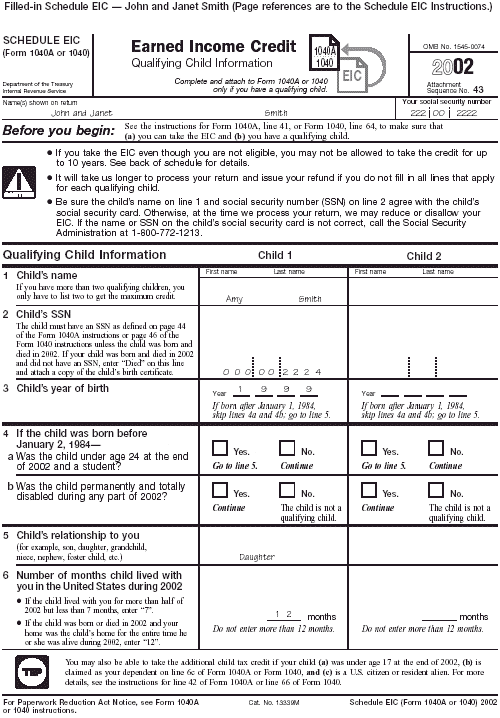
Smith's Schedule EIC
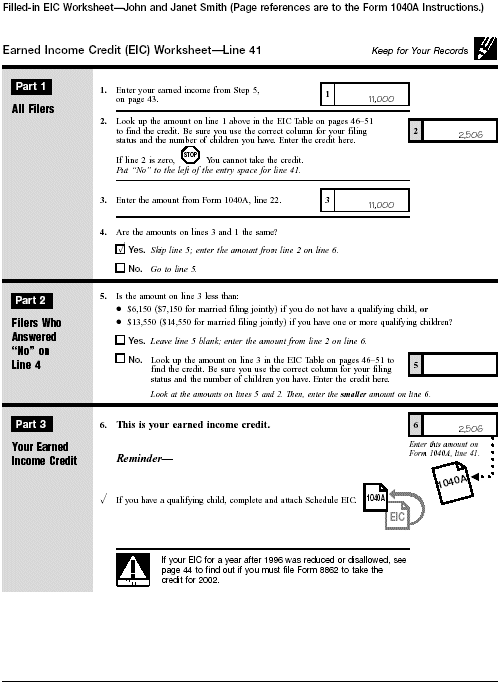
Smith's EIC Worksheet
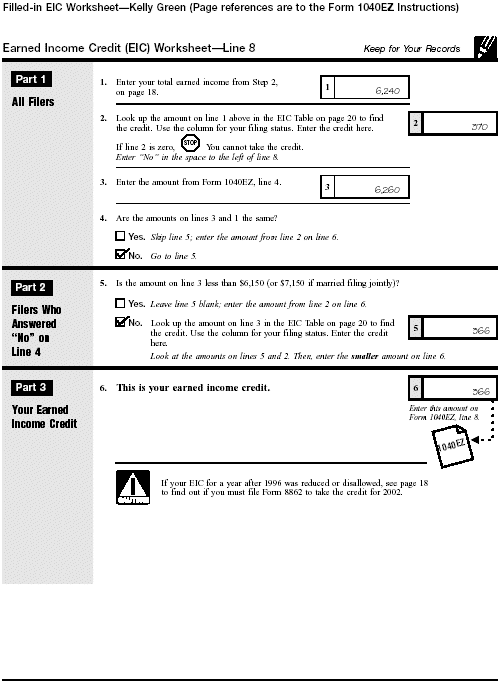
EIC worksheet-Kelly
EIC Eligibility Checklist
| You may claim the EIC if you answer YES to all the following questions.* |
| |
|
|
YES |
NO |
| 1. |
Do you, your spouse, and your qualifying child each have a valid SSN? (See Rule 1.) |
![[ ]](graphics/squ.gif) |
![[ ]](graphics/squ.gif) |
| 2. |
Is your filing status married filing jointly, head of household, qualifying widow(er), or single? (See Rule 2.) Caution: If you are a nonresident alien, answer YES only if your filing status is married filing jointly and you are married to a U.S. citizen or resident alien. (See Rule 3.) |
![[ ]](graphics/squ.gif) |
![[ ]](graphics/squ.gif) |
| 3. |
Answer YES if you are not filing Form 2555 or Form 2555-EZ. Otherwise, answer NO. (See Rule 4.) |
![[ ]](graphics/squ.gif) |
![[ ]](graphics/squ.gif) |
| 4. |
Is your investment income $2,550 or less? (See Rule 5.) |
![[ ]](graphics/squ.gif) |
![[ ]](graphics/squ.gif) |
| 5. |
Is your AGI less than: - $11,060 ($12,060 if married filing jointly) if you do not have a qualifying child,
- $29,201 ($30,201 if married filing jointly) if you have one qualifying child, or
- $33,178 ($34,178 if married filing jointly) if you have more than one qualifying child? (See Rule 15.)
|
![[ ]](graphics/squ.gif) |
![[ ]](graphics/squ.gif) |
| 6. |
Is your total earned income at least $1 but less than: - $11,060 ($12,060 if married filing jointly) if you do not have a qualifying child,
- $29,201 ($30,201 if married filing jointly) if you have one qualifying child, or
- $33,178 ($34,178 if married filing jointly) if you have more than one qualifying child? (See Rules 6 and 14.)
|
![[ ]](graphics/squ.gif) |
![[ ]](graphics/squ.gif) |
| 7. |
Answer YES if you (and your spouse if filing a joint return) are not a qualifying child of another person. Otherwise, answer NO. (See Rules 9 and 12.) |
![[ ]](graphics/squ.gif) |
![[ ]](graphics/squ.gif) |
| |
STOP |
If you have a qualifying child, answer questions 8 and 9 and skip 10-12. If you do not have a qualifying child, skip answers 8 and 9 and answer 10-12.* |
|
|
| 8. |
Does your child meet the age, residency, and relationship tests for a qualifying child? (See Rule 7.) |
![[ ]](graphics/squ.gif) |
![[ ]](graphics/squ.gif) |
| 9. |
Is your child a qualifying child only for you? Answer YES if your qualifying child also meets the tests to be a qualifying child of another person, but either (a) the other person is not claiming the EIC using that child, or (b) if the other person is claiming the EIC using that child, Rule 8 allows you and not the other person to treat the child as a qualifying child. (See Rule 8.) |
![[ ]](graphics/squ.gif) |
![[ ]](graphics/squ.gif) |
| 10. |
Was your main home (and your spouse's if filing a joint return) in the United States for more than half the year? (See Rule 13.) |
![[ ]](graphics/squ.gif) |
![[ ]](graphics/squ.gif) |
| 11. |
Were you (or your spouse if filing a joint return) at least age 25 but under 65 at the end of 2002? (See Rule 10.) |
![[ ]](graphics/squ.gif) |
![[ ]](graphics/squ.gif) |
| 12. |
Answer YES if you (and your spouse if filing a joint return) cannot be claimed as a dependent on anyone else's return. Answer NO if you (and your spouse if filing a joint return) can be claimed as a dependent on someone else's return. (See Rule 11.) |
![[ ]](graphics/squ.gif) |
![[ ]](graphics/squ.gif) |
| * |
PERSONS WITH A QUALIFYING CHILD: If you answered YES to questions 1 through 9, you can claim the EIC. Remember to fill out Schedule EIC and attach it to your Form 1040 or Form 1040A. You cannot use Form 1040EZ. |
|
|
|
| |
PERSONS WITHOUT A QUALIFYING CHILD: If you answered YES to questions 1 through 7, and 10 through 12, you can claim the EIC. |
|
|
|
| |
If you answered NO to any question that applies to you: You cannot claim the EIC. |
|
|
|
Other Credits
Important Changes
Adoption credit.
This credit, part of which was scheduled to end after 2001, has been permanently extended. In addition, beginning in 2002, the maximum adoption
credit has been increased to $10,000. The income limit based on modified adjusted gross income (AGI) has also increased. A modified AGI of more than
$150,000 will reduce your credit. No credit will be available if your modified AGI is $190,000 or more. See Adoption Credit, later.
Retirement savings contributions credit.
If you contribute to an individual retirement arrangement (IRA) or to a retirement plan sponsored by your employer, you may qualify for a tax
credit of up to $1,000 ($2,000 if married filing jointly). This credit begins in 2002 and will be in effect through 2006. See Retirement Savings
Contributions Credit, later.
Excess withholding of social security tax and tier 1 railroad retirement tax.
Social security and tier 1 railroad retirement tax (RRTA) are both withheld at a rate of 6.2% of wages. The maximum wages subject to this tax
increased to $84,900 in 2002. If you had two or more employers and they withheld too much social security or RRTA tax during 2002, you may be entitled
to a credit of the excess withholding. For more information about the credit, see Credit for Excess Social Security Tax or Railroad Retirement
Tax Withheld under Refundable Credits, later.
Health insurance credit.
Beginning December 2002, there is a new credit based on health insurance premiums paid by certain workers who are displaced by foreign trade or who
are receiving a pension from the Pension Benefit Guarantee Corporation. See Health Insurance Credit at the end of this chapter.
Introduction
This chapter discusses the following credits.
- Adoption credit.
- Foreign tax credit.
- Mortgage interest credit.
- Retirement savings contributions credit.
- Credit for prior year minimum tax.
- Credit for electric vehicles.
- Credit for excess social security tax or railroad retirement tax withheld.
- Credit for tax on undistributed capital gain.
- Health insurance credit.
Several other credits are discussed in other chapters in this publication.
- Child and dependent care credit (chapter 33).
- Credit for the elderly or the disabled (chapter 34).
- Child tax credit (chapter 35).
- Education credits (chapter 36).
- Earned income credit (chapter 37).
Nonrefundable credits.
The first part of this chapter, Nonrefundable Credits, covers six credits that you subtract directly from your tax. These credits may
reduce your tax to zero. If these credits are more than your tax, the excess is not refunded to you.
Refundable credits.
The second part of this chapter, Refundable Credits, covers three credits that are treated as payments and are refundable to you. These
credits are added to the federal income tax withheld and any estimated tax payments you made. If this total is more than your total tax, the excess
will be refunded to you.
Useful Items You may want to see:
Publication
- 502
Medical and Dental Expenses
- 514
Foreign Tax Credit for
Individuals
- 530
Tax Information for First-Time Homeowners
- 535
Business Expenses
- 564
Mutual Fund Distributions
- 590
Individual Retirement Arrangements (IRAs)
- 968
Tax Benefits for Adoption
Form (and Instructions)
- 1116
Foreign Tax Credit (Individual, Estate, or Trust)
- 2439
Notice to Shareholder of Undistributed Long-Term Capital Gains
- 8396
Mortgage Interest Credit
- 8801
Credit For Prior Year Minimum Tax - Individuals, Estates, and Trusts
- 8828
Recapture of Federal Mortgage Subsidy
- 8834
Qualified Electric Vehicle Credit
- 8839
Qualified Adoption Expenses
- 8880
Credit for Qualified Retirement Savings Contributions
- 8885
Health Insurance Credit for Eligible Recipients
Nonrefundable Credits
The following credits are discussed in this part.
- Adoption credit.
- Foreign tax credit.
- Mortgage interest credit.
- Retirement savings contributions credit.
- Credit for prior year minimum tax.
- Credit for electric vehicles.
Adoption Credit
You may be able to take a tax credit of up to $10,000 for qualifying expenses paid to adopt an eligible child.
If your modified adjusted gross income (AGI) is more than $150,000, your credit is reduced. If your modified AGI is $190,000 or more, you cannot
claim the credit.
Prior-law dollar limits of $5,000 ($6,000 for special needs child) continue to apply to expenses paid or incurred before 2002, even if you are
determining the credit for a year after 2001.
Qualifying expenses.
Qualifying adoption expenses are reasonable and necessary adoption fees, court costs, attorney fees, traveling expenses (including amounts spent
for meals and lodging) while away from home, and other expenses directly related to, and whose principal purpose is for, the legal adoption of an
eligible child.
Nonqualifying expenses.
Qualifying adoption expenses do not include expenses:
- That violate state or federal law,
- For carrying out any surrogate parenting arrangement,
- For the adoption of your spouse's child,
- Paid using funds received from any federal, state, or local program,
- Allowed as a credit or deduction under any other federal income tax rule, or
- Paid or reimbursed by your employer or any other person or organization.
Eligible child.
The term eligible child means any individual:
- Under 18 years old, or
- Physically or mentally incapable of caring for himself or herself.
Child with special needs.
An eligible child is a child with special needs if:
- He or she is a citizen or resident of the United States (including the District of Columbia and U.S. possessions) and
- A state determines that the child cannot or should not be returned to his or her parents' home and probably will not be adopted unless
adoption assistance is provided to the adoptive parents.
Factors used by states to determine if a child has special needs could include:
- The child's ethnic background,
- The child's age,
- Whether the child is a member of a minority or sibling group, or
- Whether the child has a medical condition or physical, mental, or emotional handicap.
 A foreign child cannot be treated as a child with special needs.
A foreign child cannot be treated as a child with special needs.
Foreign child.
If the child is not a U.S. citizen or resident, you cannot take the credit unless the adoption becomes final.
When to claim the credit.
Generally, for any year before the adoption becomes final, you take the credit in the year after your qualified expenses are paid or incurred. See
Publication 968 for more specific information on when to claim the credit.
How to claim the credit.
To claim the credit, you must complete Form 8839 and attach it to your Form 1040 or Form 1040A. Enter the credit on line 51, Form 1040, or line 34,
Form 1040A.
Foreign Tax Credit
You generally can choose to claim income taxes you paid or accrued during the year to a foreign country or U.S. possession as a credit against your
U.S. income tax. Or, you can deduct them as an itemized deduction (see chapter 24).
You cannot take a credit (or deduction) for foreign income taxes paid on income that is exempt from U.S. tax under the foreign earned income
exclusion or the foreign housing exclusion.
Limit on the credit.
Your foreign tax credit cannot be more than your U.S. tax liability (line 42, Form 1040) multiplied by a fraction. The numerator of the fraction is
your taxable income from sources outside the United States. The denominator is your total taxable income from U.S. and foreign sources. See
Publication 514 for more information.
How to claim the credit.
Complete Form 1116 and attach it to your Form 1040. Enter the credit on line 45, Form 1040.
Election not to file Form 1116.
You will not be subject to the limit and may be able to claim the credit without using Form 1116 if all the following requirements are met.
- You are an individual.
- Your only foreign source income for the tax year is passive income (dividends, interest, royalties, etc.) that is reported to you on a payee
statement (such as a Form 1099-DIV, Dividends and Distributions, or 1099-INT, Interest Income).
- Your qualified foreign taxes for the tax year are not more than $300 ($600 if filing a joint return) and are reported on a payee
statement.
- You elect this procedure for the tax year.
If you qualify and elect not to file Form 1116, enter the amount of your foreign taxes paid on line 45, Form 1040.
 If you make this election, you cannot carry back or carry over any unused foreign tax to or from this tax year.
If you make this election, you cannot carry back or carry over any unused foreign tax to or from this tax year.
Mortgage Interest Credit
Mortgage credit certificates issued by state and local governments may entitle a certificate holder to a mortgage interest credit. The certificate
must be used in connection with the purchase, qualified rehabilitation, or qualified home improvement of the certificate holder's main home.
Who qualifies.
You may be able to claim a mortgage interest credit if you were issued a mortgage credit certificate (MCC) under a qualified MCC
program. The MCC must relate to your main home.
Amount of credit.
If your mortgage is equal to (or smaller than) the certified indebtedness amount (loan) shown on your MCC, you multiply the certified credit rate,
shown on your MCC, by all the interest you paid on your mortgage during the year.
If your mortgage is larger than the certified indebtedness amount shown on your MCC, you multiply the certified credit rate (shown on your MCC) by
only the interest allocated to the certified indebtedness amount shown on your MCC.
If someone else (other than your spouse if filing jointly) also holds an interest in your home, you must divide the credit based on each person's
interest. See Publication 530 for further information.
 If the certificate credit rate is more than 20%, the credit cannot be more than $2,000.
If the certificate credit rate is more than 20%, the credit cannot be more than $2,000.
Carryforward.
If your allowable credit is more than your tax liability reduced by certain credits, you can carry forward the unused portion of the credit to your
next 3 tax years or until used, whichever comes first.
If you are subject to the $2,000 limit because your certificate credit rate is more than 20%, no amount over the $2,000 (or your prorated share of
the $2,000 if you must allocate the credit) may be carried forward.
How to claim the credit.
Figure your 2002 credit and any carryforward to 2003 on Form 8396, and attach it to your Form 1040. Be sure to include any credit carryforward from
1999, 2000, and 2001.
Include the credit in your total for line 52, Form 1040, and check box a.
Reduced home mortgage interest deduction.
If you claim the credit and itemize your deductions on Schedule A (Form 1040), you must reduce your home mortgage interest deduction. Reduce your
deduction by the amount on line 3 of Form 8396, even if part of that amount is to be carried forward to 2003. For more information about the home
mortgage interest deduction, see chapter 25.
Recapture of federal mortgage subsidy.
If you received an MCC with your mortgage loan, you may be subject to a recapture rule. The recapture may be required if you sell or dispose of
your home at a gain during the first 9 years after the date you closed your mortgage loan. See Publication 523, Selling Your Home, for more
information.
Retirement Savings Contributions Credit
Beginning in 2002, you may be able to take a tax credit of up to $1,000 ($2,000 if married filing jointly) for making eligible contributions to an
employer-sponsored retirement plan or to an individual retirement arrangement (IRA). The credit is a percentage of the qualifying contributions, with
the highest rate for taxpayers with the least income.
You cannot claim this credit if any of the following apply.
- The amount of your 2002 adjusted gross income (discussed next) is more than $25,000 ($37,500 if head of household, $50,000 if married filing
jointly).
- You were born after January 1, 1985.
- You are claimed as a dependent on another person's 2002 tax return.
- You were a full-time student in 2002.
The amount of credit you can take depends on your filing status, your adjusted gross income (AGI), and your eligible contributions.
Adjusted gross income (AGI).
This is generally the amount on Form 1040, line 36, or Form 1040A, line 22. However, you must add to that amount any exclusion or deduction claimed
for the year for:
- Foreign earned income,
- Foreign housing costs,
- Income for residents of American Samoa, and
- Income from Puerto Rico.
You can use Table 38-1
to find the percentage of your eligible contributions you qualify to use. For example, if you
are single with an AGI of $15,000, you may be entitled to a credit equal to 50% of your eligible contributions (defined next).
Eligible contributions.
These include contributions to a traditional or Roth IRA and salary reduction contributions to most employer-sponsored retirement plans. They also
include certain voluntary after-tax employee contributions.
Contributions reduced.
Your eligible contributions must be reduced by certain taxable and nontaxable distributions made after 1999 and before the due date (including
extensions) of your 2002 tax return.
See Publication 590, chapter 5, for more specific information on eligible contributions and the reductions you must make.
Limit on the credit.
After your contributions are reduced, the maximum annual contributions on which you can base the credit is $2,000 per person. This makes the
maximum possible credit $1,000 per return ($2,000 if married filing jointly).
| Table 38-1. |
Applicable Percentage for Retirement Savings Contributions Credit |
| IF your filing status is ... |
AND your AGI is ... |
THEN your applicable percentage is ... |
| married filing jointly |
Not over $30,000 |
50% |
| Over $30,000, but not over $32,500 |
20% |
| Over $32,500, but not over $50,000 |
10% |
| Over $50,000 |
0% |
| head of household |
Not over $22,500 |
50% |
| Over $22,500, but not over $24,375 |
20% |
| Over $24,375, but not over $37,500 |
10% |
| Over $37,500 |
0% |
| single, qualifying widow(er), or married filing separately |
Not over $15,000 |
50% |
| Over $15,000, but not over $16,250 |
20% |
| Over $16,250, but not over $25,000 |
10% |
| Over $25,000 |
0% |
Example.
During 2002, you contributed $3,000 to your 401(k) plan and made a $500 IRA withdrawal. You also took a $900 IRA withdrawal in 2001. Neither of
your withdrawals was rolled over. The amount of your 2002 plan contributions eligible for the credit is $1,600 ($3,000 - $500 - $900). If
you are single and your AGI is $24,500, your applicable percentage from Table 38-1 is 10%. Therefore, your retirement savings
contributions credit is $160 ($1,600 × 10%).
How to claim the credit.
To claim the credit, complete Form 8880 and attach it to your Form 1040 or 1040A. Enter the credit on line 49, Form 1040, or line 32, Form 1040A.
The credit you compute on Form 8880 will take into account any nonrefundable credits that have already reduced your tax (such as the credit for
child and dependent care expenses). If your tax liability is reduced to zero because of other nonrefundable credits, you will not be entitled to the
credit for retirement savings contributions.
Credit for Prior Year Minimum Tax
The tax laws give special treatment to some kinds of income and allow special deductions and credits for some kinds of expenses. If you benefit
from these laws, you may have to pay at least a minimum amount of tax in addition to any other tax on these items. This is called the alternative
minimum tax.
The special treatment of some items of income and expenses only allows you to postpone paying tax until a later year. If in prior years you paid
alternative minimum tax because of these tax postponement items, you may be able to claim a credit for prior year minimum tax against your current
year's regular tax. The amount of the credit cannot reduce your current year's tax below your current year's tentative alternative minimum tax.
You may be able to take a credit against your regular tax if you:
- Paid alternative minimum tax in 2001,
- Had an unused minimum tax credit that you are carrying forward from 2001 to 2002, or
- Had unallowed qualified electric vehicle credits in 2001.
How to claim the credit.
Figure your 2002 credit and any carryforward to 2003 on Form 8801, and attach it to your Form 1040. Include the credit in your total for line 53,
Form 1040, and check box b. You can carry forward any unused credit for prior year minimum tax to later years until it is completely used.
For additional information about the credit, see the instructions for Form 8801.
Credit for Electric Vehicles
You may be allowed a tax credit if you placed a qualified electric vehicle in service during the year.
Congress is considering legislation that would expand the definition of qualified electric vehicle, vary the amount of credit allowed according to
the vehicle type, and allow any unused credit to be used to reduce federal income tax in other years. If passed, the information will be included in
Publication 553, Highlights of 2002 Tax Changes.
Qualified electric vehicle.
This is a motor vehicle that:
- Has at least four wheels and is manufactured primarily for use on public streets, roads, and highways,
- Is powered primarily by an electric motor drawing current from rechargeable batteries, fuel cells, or other portable sources of
electrical current,
- Is originally used by you,
- Is acquired for your own use, not for resale,
- Has never been used as a nonelectric vehicle, and
- Is used predominately in the United States.
Amount of credit.
If you placed a qualified electric vehicle in service during 2002, the credit is generally 10% of the cost of the vehicle. However, if the vehicle
is a depreciable business asset, you must reduce the cost of the vehicle by any section 179 deduction before figuring the credit. Get Publication 463,
Travel, Entertainment, Gift, and Car Expenses, for information on the section 179 deduction.
The credit is limited to $4,000 for each vehicle placed in service in 2002.
Recapture.
The credit will be subject to recapture if, within 3 years after the date you place the vehicle in service, the vehicle is used predominately
outside the United States or is modified (or its use is modified) so that it is no longer eligible for the credit. You recapture the credit by adding
part or all of it to your income tax for the year in which the recapture event occurs. See chapter 12 of Publication 535 for more information.
How to claim the credit.
To claim the credit, complete Form 8834 and attach it to your Form 1040. Include the credit in your total for line 53, Form 1040. Check box c, and
print 8834 on the line next to box c.
Do not confuse this credit with the Deduction for clean-fuel vehicles that is reported on Form 1040, line 34.
Refundable Credits
The following credits are refundable and are treated as payments of tax.
- Credit for excess social security tax or railroad retirement tax withheld.
- Credit for tax on undistributed capital gain.
- Health insurance credit.
Credit for Excess Social Security Tax or Railroad Retirement Tax Withheld
Most employers must withhold social security tax from your wages. If you work for a railroad employer, that employer must withhold tier 1 railroad
retirement (RRTA) tax and tier 2 RRTA tax.
If you worked for two or more employers in 2002, you may have had too much social security or RRTA tax withheld from your pay. You can claim the
excess social security or RRTA tier 1 tax as a credit against your income tax. The following table shows the maximum amount of wages subject to tax
and the maximum amount of tax that should have been withheld in 2002.
| Type of tax |
Maximum wages subject to tax |
Maximum tax that should have been withheld |
| Social security or RRTA tier 1 |
$84,900 |
$5,263.80 |
| RRTA tier 2 |
$63,000 |
$3,087.00 |
 All wages are subject to Medicare tax withholding.
All wages are subject to Medicare tax withholding.
 Use Form 843, Claim for Refund and Request for Abatement, to claim a refund of excess RRTA tier 2 tax. See Publication 505, Tax
Withholding and Estimated Tax, for details.
Use Form 843, Claim for Refund and Request for Abatement, to claim a refund of excess RRTA tier 2 tax. See Publication 505, Tax
Withholding and Estimated Tax, for details.
One employer.
If any one employer withheld social security or RRTA tax that exceeded the amounts in the preceding table, you cannot claim the extra amount
withheld by that employer as a credit against your income tax. Your employer must adjust this for you.
Joint return.
If you are filing a joint return, you cannot add the social security or RRTA tax withheld from your spouse's wages to the amount withheld from your
wages. Figure the credit separately for you and your spouse to determine if either of you has excess withholding.
How to claim the credit.
If you file Form 1040, enter the credit on line 65. If you file Form 1040A, include the credit in the total on line 43 and put Excess SST
and the amount of the credit in the space to the left of the line.
How to figure the credit if you did not work for a railroad.
If you did not work for a railroad during 2002, figure the credit as follows:
| 1. |
Add all social security tax withheld (but not more than $5,263.80 for each employer). Enter the total here |
|
| 2. |
Enter any uncollected social security tax on tips or group-term life insurance included in the total on Form 1040, line 61 |
|
| 3. |
Add lines 1 and 2. If $5,263.80 or less, stop here. You cannot claim the credit |
|
| 4. |
Social security tax limit |
5,263.80 |
| 5. |
Credit. Subtract line 4 from line 3. Enter the result here and on Form 1040, line 65 (or Form 1040A, line 43) |
|
Example.
You are married and file a joint return with your spouse who had no gross income in 2002. During 2002, you worked for the Brown Shoe Company and
earned $48,000 in wages. Social security tax of $2,976 was withheld. You also worked for another employer in 2002 and earned $40,000 in wages. $2,480
of social security tax was withheld from these wages. Because you worked for more than one employer and your total wages were more than $84,900, you
can claim a credit of $192.20 for the excess social security tax withheld.
| 1. |
Add all social security tax withheld (but not more than $5,263.80 for each employer). Enter the total here |
$5,456.00 |
| 2. |
Enter any uncollected social security tax on tips or group-term life insurance included in the total on Form 1040, line 61 |
-0- |
| 3. |
Add lines 1 and 2. If $5,263.80 or less, stop here. You cannot claim the credit |
5,456.00 |
| 4. |
Social security tax limit |
5,263.80 |
| 5. |
Credit. Subtract line 4 from line 3. Enter the result here and on Form 1040, line 65 (or Form 1040A, line 43) |
$ 192.20 |
How to figure the credit if you worked for a railroad.
If you were a railroad employee during 2002, figure the credit as follows:
| 1. |
Add all social security and tier 1 RRTA tax withheld (but not more than $5,263.80 for each employer). Enter the total here |
|
| 2. |
Enter any uncollected social security and tier 1 RRTA tax on tips or group-term life insurance included in the total on Form 1040, line 61 |
|
| 3. |
Add lines 1 and 2. If $5,263.80 or less, stop here. You cannot claim the credit |
|
| 4. |
Social security and tier 1 RRTA tax limit |
5,263.80 |
| 5. |
Credit. Subtract line 4 from line 3. Enter the result here and on Form 1040, line 65 (or Form 1040A, line 43) |
|
Credit for Tax on Undistributed Capital Gain
You must include in your income any amounts that regulated investment companies (commonly called mutual funds) or real estate investment trusts
(REITs) allocated to you as capital gain distributions, even if you did not actually receive them. If the mutual fund or REIT paid a tax on the
capital gain, you are allowed a credit for the tax since it is considered paid by you. The mutual fund or REIT will send you Form 2439, Notice to
Shareholder of Undistributed Long-Term Capital Gains, showing the undistributed capital gains and the tax paid, if any. Claim the credit for the
tax paid by entering the amount on line 68, Form 1040, and checking box a. Attach Copy B of Form 2439 to your return. See Capital Gain
Distributions in chapter 9 for more information on undistributed capital gains.
Health Insurance Credit
Beginning December 2002, if you are an eligible individual, you can claim a tax credit equal to 65% of the amount you pay for qualifying health
insurance for yourself, your spouse, and your dependents for whom you can claim an exemption on your tax return. Eligibility for the credit is
determined on a monthly basis, as of the first day of each month.
You are an eligible individual for any month you are one of the following recipients.
- Eligible TAA recipient - You receive a trade adjustment allowance (TAA) for individuals for at least one day in the month, or would
receive a TAA but do not because you have not yet exhausted your unemployment benefits and you are covered under a TAA certification.
- Eligible alternative TAA recipient - You receive a supplemental wage allowance under section 246(a)(1) of the Trade Act of
1974.
- Eligible PBGC pension recipient - You are at least 55 years old and are receiving pension benefits from the Pension Benefit Guarantee
Corporation (PBGC).
For specific information about qualifying health insurance and eligibility requirements, see Publication 502, Medical and Dental
Expenses.
To claim the credit, complete Form 8885 and attach it to your Form 1040 (or Form 1040NR). Include your credit in the total for line 68, Form 1040
(line 63, Form 1040NR), and check box c.
If you claim this credit, you cannot take the same expenses into account in determining your:
- Medical and dental expenses on Schedule A (Form 1040),
- Self-employed health insurance deduction, or
- Archer MSA distribution.
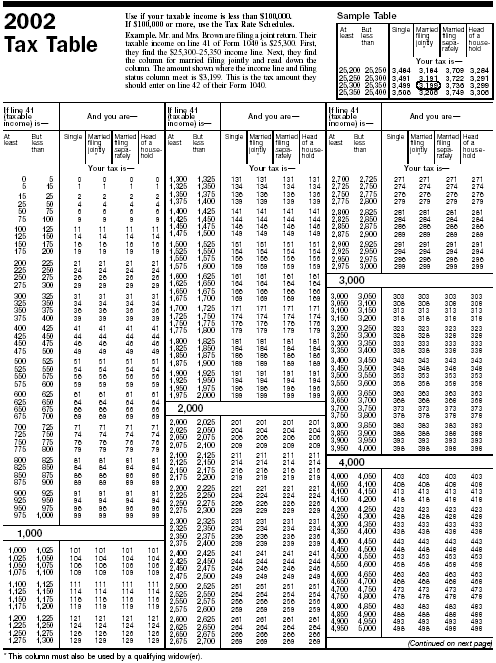
Tax Table-1
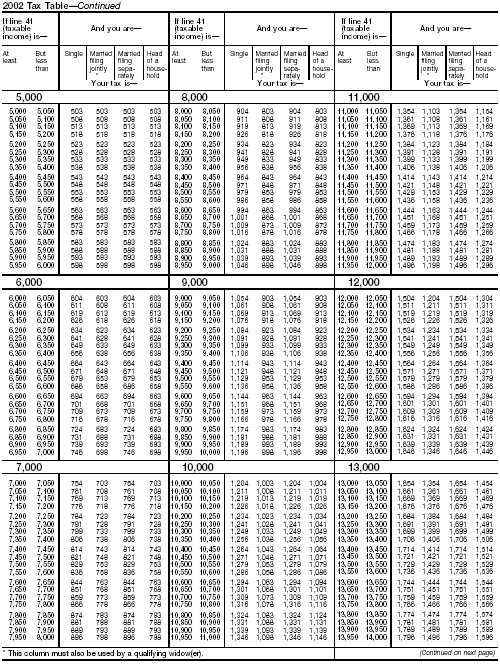
Tax Table-2
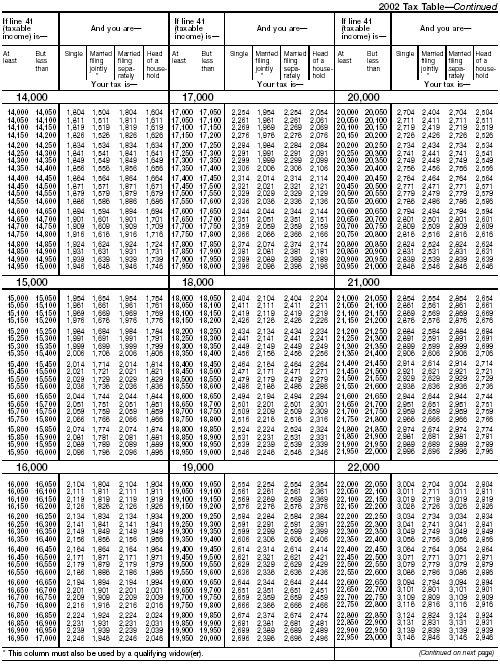
Tax Table-3
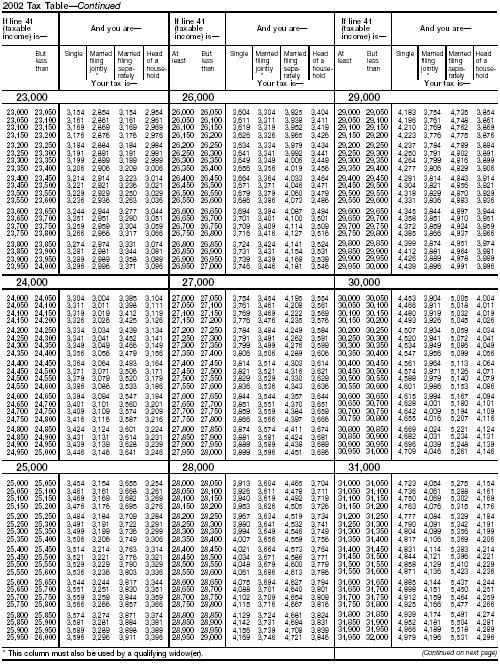
Tax Table-4
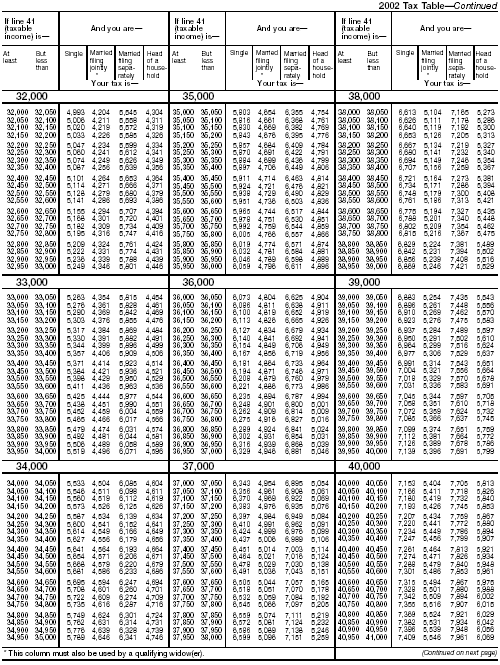
Tax Table-5
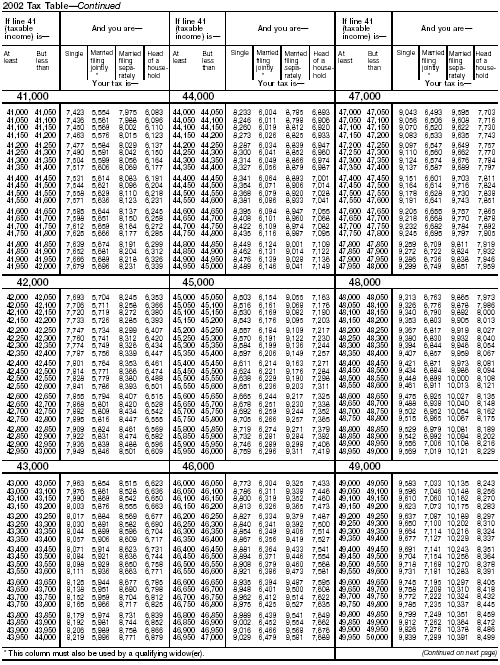
Tax Table-6
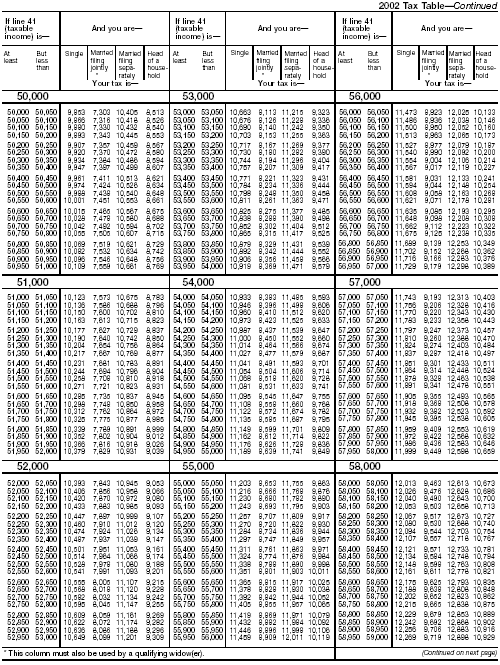
Tax Table-7
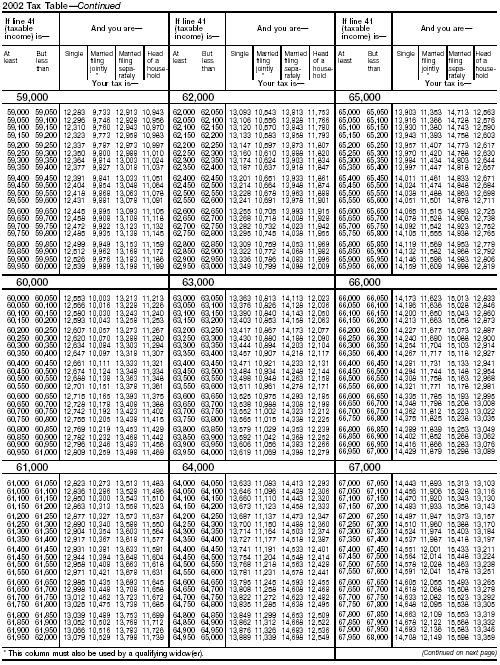
Tax Table-8
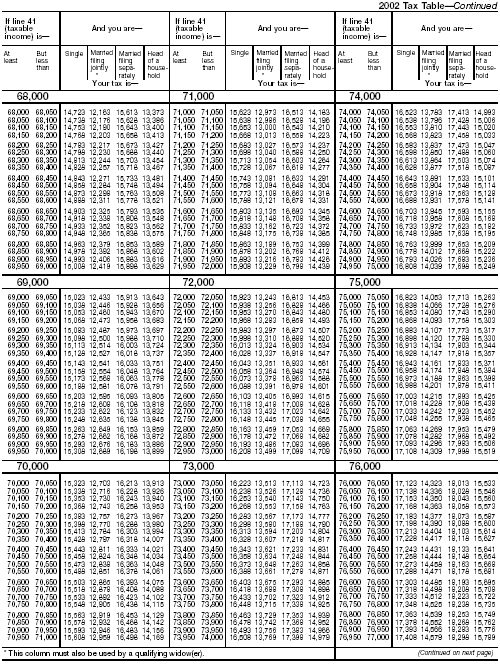
Tax Table-9
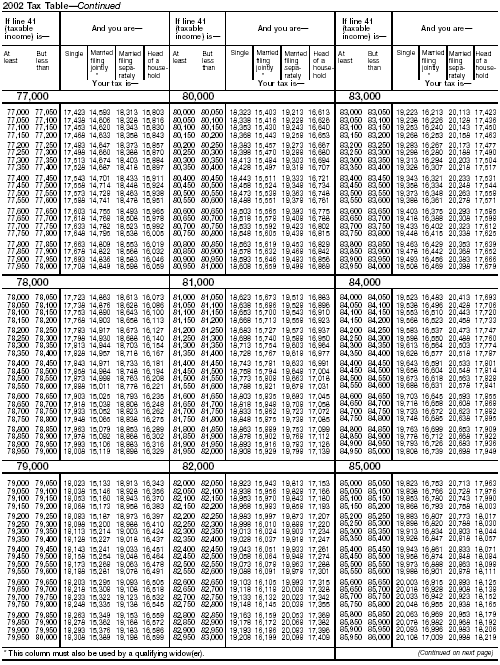
Tax Table-10
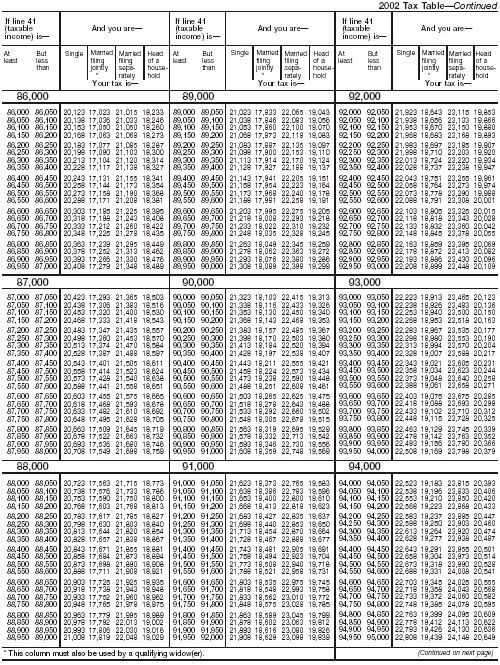
Tax Table-11
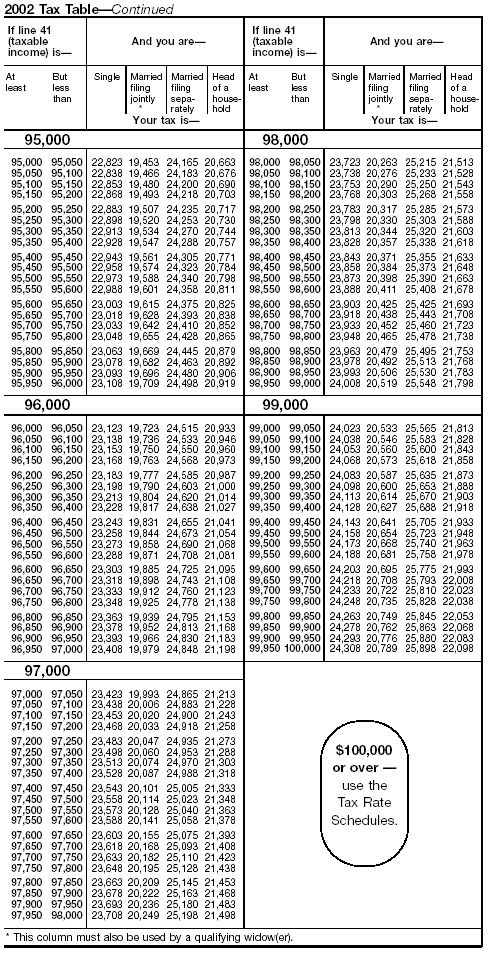
Tax Table-12
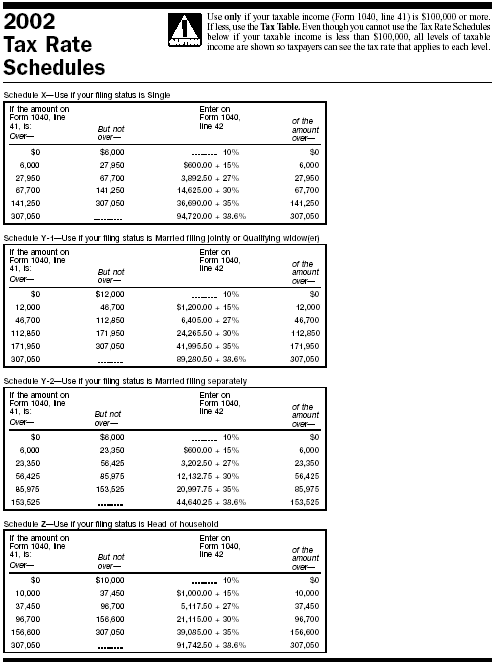
Tax Rate Schedule
Your Rights as a Taxpayer
The first part of this section explains some of your most important rights as a taxpayer. The second part explains the examination, appeal,
collection, and refund processes.
Declaration of Taxpayer Rights
Protection of your rights.
IRS employees will explain and protect your rights as a taxpayer throughout your contact with us.
Privacy and confidentiality.
The IRS will not disclose to anyone the information you give us, except as authorized by law. You have the right to know why we are asking you for
information, how we will use it, and what happens if you do not provide requested information.
Professional and courteous service.
If you believe that an IRS employee has not treated you in a professional, fair, and courteous manner, you should tell that employee's supervisor.
If the supervisor's response is not satisfactory, you should write to the IRS director for your area or the center where you filed your return.
Representation.
You may either represent yourself or, with proper written authorization, have someone else represent you in your place. Your representative must be
a person allowed to practice before the IRS, such as an attorney, certified public accountant, or enrolled agent. If you are in an interview and ask
to consult such a person, then we must stop and reschedule the interview in most cases.
You can have someone accompany you at an interview. You may make sound recordings of any meetings with our examination, or collection personnel,
provided you tell us in writing 10 days before the meeting.
Payment of only the correct amount of tax.
You are responsible for paying only the correct amount of tax due under the law - no more, no less. If you cannot pay all of your tax when it
is due, you may be able to make monthly installment payments.
Help with unresolved tax problems.
See How To Get Tax Help.
Appeals and judicial review.
If you disagree with us about the amount of your tax liability or certain collection actions, you have the right to ask the Appeals Office to
review your case. You may also ask a court to review your case.
Relief from certain penalties and interest.
The IRS will waive penalties when allowed by law if you can show you acted reasonably and in good faith or relied on the incorrect advice of an IRS
employee. We will waive interest that is the result of certain errors or delays caused by an IRS employee.
Examinations, Appeals, Collections, and Refunds
Examinations (Audits)
We accept most taxpayers' returns as filed. If we inquire about your return or select it for examination, it does not suggest that you are
dishonest. The inquiry or examination may or may not result in more tax. We may close your case without change; or, you may receive a refund.
The process of selecting a return for examination usually begins in one of two ways. First, we use computer programs to identify returns that may
have incorrect amounts. These programs may be based on information returns, such as Forms 1099 and W-2, on studies of past examinations, or on
certain issues identified by compliance projects. Second, we use information from outside sources that indicates that a return may have incorrect
amounts. These sources may include newspapers, public records, and individuals. If we determine that the information is accurate and reliable, we may
use it to select a return for examination.
Publication 556, Examination of Returns, Appeal Rights, and Claims for Refund, explains the rules and procedures that we follow in
examinations. The following sections give an overview of how we conduct examinations.
By mail.
We handle many examinations and inquiries by mail. We will send you a letter with either a request for more information or a reason why we believe
a change to your return may be needed. You can respond by mail or you can request a personal interview with an examiner. If you mail us the requested
information or provide an explanation, we may or may not agree with you, and we will explain the reasons for any changes. Please do not hesitate to
write to us about anything you do not understand.
By interview.
If we notify you that we will conduct your examination through a personal interview, or you request such an interview, you have the right to ask
that the examination take place at a reasonable time and place that is convenient for both you and the IRS. If our examiner proposes any changes to
your return, he or she will explain the reasons for the changes. If you do not agree with these changes, you can meet with the examiner's supervisor.
Repeat examinations.
If we examined your return for the same items in either of the 2 previous years and proposed no change to your tax liability, please contact us as
soon as possible so we can see if we should discontinue the examination.
Appeals
If you do not agree with the examiner's proposed changes, you can appeal them to the Appeals Office of IRS. Most differences can be settled without
expensive and time-consuming court trials. Your appeal rights are explained in detail in both Publication 5, Your Appeal Rights and How To
Prepare a Protest If You Don't Agree, and Publication 556, Examination of Returns, Appeal Rights, and Claims for Refund.
If you do not wish to use the Appeals Office or disagree with its findings, you may be able to take your case to the U.S. Tax Court, U.S. Court of
Federal Claims, or the U.S. District Court where you live. If you take your case to court, the IRS will have the burden of proving certain facts if
you kept adequate records to show your tax liability, cooperated with the IRS, and meet certain other conditions. If the court agrees with you on most
issues in your case and finds that our position was largely unjustified, you may be able to recover some of your administrative and litigation costs.
You will not be eligible to recover these costs unless you tried to resolve your case administratively, including going through the appeals system,
and you gave us the information necessary to resolve the case.
Collections
Publication 594, The IRS Collection Process, explains your rights and responsibilities regarding payment of federal taxes. It describes:
- What to do when you owe taxes. It describes what to do if you get a tax bill and what to do if you think your bill is wrong. It also covers
making installment payments, delaying collection action, and submitting an offer in compromise.
- IRS collection actions. It covers liens, releasing a lien, levies, releasing a levy, seizures and sales, and release of
property.
Your collection appeal rights are explained in detail in Publication 1660, Collection Appeal Rights.
Innocent spouse relief.
Generally, both you and your spouse are responsible, jointly and individually, for paying the full amount of any tax, interest, or penalties due on
your joint return. However, if you qualify for innocent spouse relief, you may not have to pay the tax, interest, and penalties related to your spouse
(or former spouse). For information on innocent spouse relief and two other ways to get relief, see Publication 971, Innocent Spouse Relief,
and Form 8857, Request for Innocent Spouse Relief (And Separation of Liability and Equitable Relief).
Refunds
You may file a claim for refund if you think you paid too much tax. You must generally file the claim within 3 years from the date you filed your
original return or 2 years from the date you paid the tax, whichever is later. The law generally provides for interest on your refund if it is not
paid within 45 days of the date you filed your return or claim for refund. Publication 556, Examination of Returns, Appeals Rights, and Claims
for Refund, has more information on refunds.
If you were due a refund but you did not file a return, you must file within 3 years from the date the return was originally due to get that
refund.
How To Get Tax Help
You can get help with unresolved tax issues, order free publications and forms, ask tax questions, and get more information from the IRS in several
ways. By selecting the method that is best for you, you will have quick and easy access to tax help.
Contacting your Taxpayer Advocate.
If you have attempted to deal with an IRS problem unsuccessfully, you should contact your Taxpayer Advocate.
The Taxpayer Advocate represents your interests and concerns within the IRS by protecting your rights and resolving problems that have not been
fixed through normal channels. While Taxpayer Advocates cannot change the tax law or make a technical tax decision, they can clear up problems that
resulted from previous contacts and ensure that your case is given a complete and impartial review.
To contact your Taxpayer Advocate:
- Call the Taxpayer Advocate at
1-877-777-4778.
- Call, write, or fax the Taxpayer Advocate office in your area.
- Call 1-800-829-4059 if you are a
TTY/TDD user.
For more information, see Publication 1546, The Taxpayer Advocate Service of the IRS.
Free tax services.
To find out what services are available, get Publication 910, Guide to Free Tax Services. It contains a list of free tax publications
and an index of tax topics. It also describes other free tax information services, including tax education and assistance programs and a list of
TeleTax topics.
 Personal computer. With your personal computer and modem, you can access the IRS on the Internet at www.irs.gov. While
visiting our web site, you can:
Personal computer. With your personal computer and modem, you can access the IRS on the Internet at www.irs.gov. While
visiting our web site, you can:
- See answers to frequently asked tax questions or request help by e-mail.
- Download forms and publications or search for forms and publications by topic or keyword.
- View forms that may be filled in electronically, print the completed form, and then save the form for recordkeeping.
- View Internal Revenue Bulletins published in the last few years.
- Search regulations and the Internal Revenue Code.
- Receive our electronic newsletters on hot tax issues and news.
- Learn about the benefits of filing electronically (IRS e-file).
- Get information on starting and operating a small business.
You can also reach us with your computer using File Transfer Protocol at ftp.irs.gov.
 TaxFax Service. Using the phone attached to your fax machine, you can receive forms and instructions by calling
703-368-9694. Follow the directions from the prompts. When you order forms, enter the catalog number for the form you need. The
items you request will be faxed to you.
TaxFax Service. Using the phone attached to your fax machine, you can receive forms and instructions by calling
703-368-9694. Follow the directions from the prompts. When you order forms, enter the catalog number for the form you need. The
items you request will be faxed to you.
For help with transmission problems, call the FedWorld Help Desk at 703-487-4608.
 Phone. Many services are available by phone.
Phone. Many services are available by phone.
- Ordering forms, instructions, and publications. Call 1-800-829-3676 to order current and prior year
forms, instructions, and publications.
- Asking tax questions. Call the IRS with your tax questions at 1-800-829-1040.
- Solving problems. Take advantage of Everyday Tax Solutions service by calling your local IRS office to set up an in-person
appointment at your convenience. Check your local directory assistance or www.irs.gov for the numbers.
- TTY/TDD equipment. If you have access to TTY/TDD equipment, call 1-800-829- 4059 to ask tax
questions or to order forms and publications.
- TeleTax topics. Call 1-800-829-4477 to listen to pre-recorded messages covering various tax
topics.
Evaluating the quality of our telephone services. To ensure that IRS representatives give accurate, courteous, and professional answers,
we use several methods to evaluate the quality of our telephone services. One method is for a second IRS representative to sometimes listen in on or
record telephone calls. Another is to ask some callers to complete a short survey at the end of the call.
 Walk-in. Many products and services are available on a walk-in basis.
Walk-in. Many products and services are available on a walk-in basis.
- Products. You can walk in to many post offices, libraries, and IRS offices to pick up certain forms, instructions, and
publications. Some IRS offices, libraries, grocery stores, copy centers, city and county governments, credit unions, and office supply stores have an
extensive collection of products available to print from a CD-ROM or photocopy from reproducible proofs. Also, some IRS offices and libraries have the
Internal Revenue Code, regulations, Internal Revenue Bulletins, and Cumulative Bulletins available for research purposes
- Services. You can walk in to your local IRS office to ask tax questions or get help with a tax problem. Now you can set up an
appointment by calling your local IRS office number and, at the prompt, leaving a message requesting Everyday Tax Solutions help. A representative
will call you back within 2 business days to schedule an in-person appointment at your convenience.
 Mail. You can send your order for forms, instructions, and publications to the Distribution Center nearest to you and receive a response
within 10 workdays after your request is received. Find the address that applies to your part of the country.
Mail. You can send your order for forms, instructions, and publications to the Distribution Center nearest to you and receive a response
within 10 workdays after your request is received. Find the address that applies to your part of the country.
- Western part of U.S.:
Western Area Distribution Center
Rancho Cordova, CA 95743-0001
- Central part of U.S.:
Central Area Distribution Center
P.O. Box 8903
Bloomington, IL 61702-8903
- Eastern part of U.S. and foreign addresses:
Eastern Area Distribution Center
P.O. Box 85074
Richmond, VA 23261-5074
 CD-ROM. You can order IRS Publication 1796, Federal Tax Products on CD-ROM, and obtain:
CD-ROM. You can order IRS Publication 1796, Federal Tax Products on CD-ROM, and obtain:
- Current tax forms, instructions, and publications.
- Prior-year tax forms and instructions.
- Popular tax forms that may be filled in electronically, printed out for submission, and saved for recordkeeping.
- Internal Revenue Bulletins.
The CD-ROM can be purchased from National Technical Information Service (NTIS) by calling 1-877-233-6767 or on the
Internet at www.irs.gov/cdorders. The first release is available in early January and the final release is available in late February.
 CD-ROM for small businesses. IRS Publication 3207, Small Business Resource Guide, is a must for every small business owner or
any taxpayer about to start a business. This handy, interactive CD contains all the business tax forms, instructions and publications needed to
successfully manage a business. In addition, the CD provides an abundance of other helpful information, such as how to prepare a business plan,
finding financing for your business, and much more. The design of the CD makes finding information easy and quick and incorporates file formats and
browsers that can be run on virtually any desktop or laptop computer.
CD-ROM for small businesses. IRS Publication 3207, Small Business Resource Guide, is a must for every small business owner or
any taxpayer about to start a business. This handy, interactive CD contains all the business tax forms, instructions and publications needed to
successfully manage a business. In addition, the CD provides an abundance of other helpful information, such as how to prepare a business plan,
finding financing for your business, and much more. The design of the CD makes finding information easy and quick and incorporates file formats and
browsers that can be run on virtually any desktop or laptop computer.
It is available in March. You can get a free copy by calling 1-800-829-3676 or by visiting the website at
www.irs.gov/smallbiz.
Written tax questions.
You can send your written tax questions to your IRS office. You should get an answer in about 30 days. If you do not have the address, you can get
it by calling 1-800-829-1040. Do not send tax questions with your return.
Braille tax materials.
A variety of Braille tax products can be ordered at no charge by calling the IRS at 1-800-829-3676. You can also download
accessible products by visiting the Accessibility section of the IRS web site at www.irs.gov.
Braille tax materials are available for review from Regional Libraries for the Visually Impaired in conjunction with the National Library Service
for the Blind and Physically Handicapped. To locate your nearest library, call 1-800- 424-8567. Braille materials
currently available for review include this publication, Publication 334, Tax Guide for Small Business, and Forms 1040, 1040A, and 1040EZ.
All of these products come with related schedules, instructions and tax tables.
Free help in preparing your return.
Free help in preparing your return is available nationwide from IRS-trained volunteers. The Volunteer Income Tax Assistance
(VITA)program is designed to help low-income taxpayers and the Tax Counseling for the Elderly (TCE) program is designed to
assist taxpayers age 60 or older with their tax returns. Some locations offer free electronic filing. See IRS e-file in chapter
1 for information on electronic filing.
Call the IRS for the location of the volunteer assistance site near you. For the location of an American Association of Retired Persons (AARP)
Tax-Aide site in your community, call 1-888-227-7669 or visit their Internet Web Site at
www.aarp.org/taxaide.
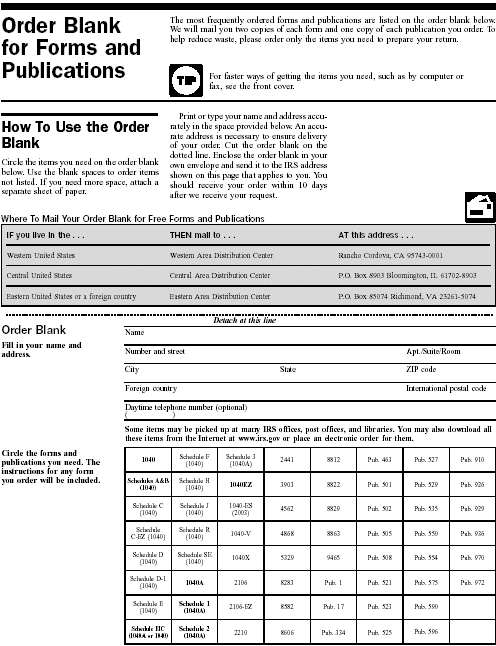
Order Blank for Forms and Publications
Previous | First
Publication 17 | 2002 Tax Year Archives | Tax Help Archives | Home
